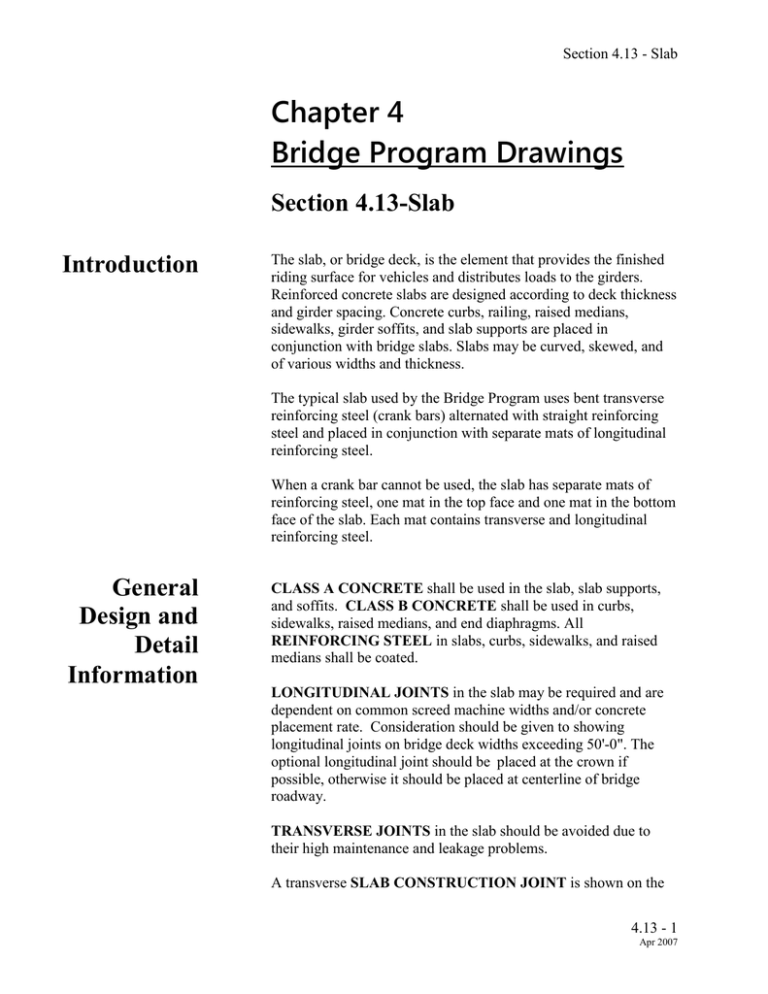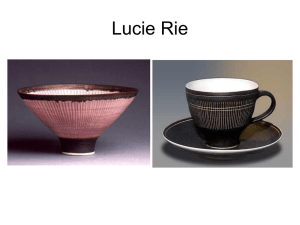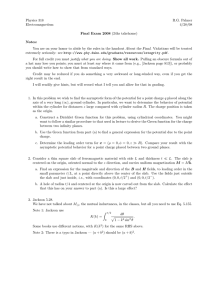Section 4.13
advertisement

Section 4.13 - Slab Chapter 4 Bridge Program Drawings Section 4.13-Slab Introduction The slab, or bridge deck, is the element that provides the finished riding surface for vehicles and distributes loads to the girders. Reinforced concrete slabs are designed according to deck thickness and girder spacing. Concrete curbs, railing, raised medians, sidewalks, girder soffits, and slab supports are placed in conjunction with bridge slabs. Slabs may be curved, skewed, and of various widths and thickness. The typical slab used by the Bridge Program uses bent transverse reinforcing steel (crank bars) alternated with straight reinforcing steel and placed in conjunction with separate mats of longitudinal reinforcing steel. When a crank bar cannot be used, the slab has separate mats of reinforcing steel, one mat in the top face and one mat in the bottom face of the slab. Each mat contains transverse and longitudinal reinforcing steel. General Design and Detail Information CLASS A CONCRETE shall be used in the slab, slab supports, and soffits. CLASS B CONCRETE shall be used in curbs, sidewalks, raised medians, and end diaphragms. All REINFORCING STEEL in slabs, curbs, sidewalks, and raised medians shall be coated. LONGITUDINAL JOINTS in the slab may be required and are dependent on common screed machine widths and/or concrete placement rate. Consideration should be given to showing longitudinal joints on bridge deck widths exceeding 50'-0". The optional longitudinal joint should be placed at the crown if possible, otherwise it should be placed at centerline of bridge roadway. TRANSVERSE JOINTS in the slab should be avoided due to their high maintenance and leakage problems. A transverse SLAB CONSTRUCTION JOINT is shown on the 4.13 - 1 Apr 2007 Section 4.13 - Slab plans in case of a construction emergency. SUPERELEVATION, CROWN, or the transverse slope of the roadway, shall match that shown on Project Development Program sheets. Longitudinal reinforcing steel provided in the top layer of the slab over the intermediate supports will typically be No. 6 bars spaced at approximately 7" to 8". These bars will extend to the quarter point of the longer span, and shall be placed symmetrically about the centerline of the support. The top layer of longitudinal reinforcing steel in the remainder of the deck shall be lapped with these bars. For composite structures, longitudinal reinforcing steel will need to be designed by the engineer, and will depend on whether the shear connectors (studs) are placed along the entire length of the girder or only in the areas of positive moment. For slabs that are integral with the abutments, a bent bar is provided between the abutment and the slab. Its length is based on the following formula. DISTRIBUTION REINFORCING STEEL (No.5 bars) is the longitudinal reinforcing steel placed in the bottom of the slab and is based on the following diagrams. 4.13 - 2 Apr 2007 Section 4.13 - Slab 4.13 - 3 Apr 2007 Section 4.13 - Slab For slabs that have SKEWS LESS THAN OR EQUAL TO 20 DEGREES, the transverse reinforcing steel shall be placed parallel with the substructure and dimensioned along the edge of the slab. Consideration should be given to placing this reinforcing steel parallel with the substructure on bridges of any skew with composite girders due to possible clearance problems with the shear connectors. For slabs that have SKEWS GREATER THAN 20 DEGREES, the transverse reinforcing steel shall be placed perpendicular to the centerline of the structure or to the girders. For slabs that are CURVED, the transverse reinforcing steel may be placed perpendicular to and dimensioned along the long chord or working line, or placed radially and dimensioned along the centerline or working line of the structure. Transverse reinforcing steel may also be dimensioned along the outside edges of the slab. Typically, crank bars are not used with curved slabs. SLAB SUPPORTS are used when an expansion device is required for bridge movement. These areas are reinforced to withstand traffic loads and tie in the anchorage system of the device. Expansion devices are covered in Section 4.09 - Superstructure. Reinforcing steel in the slab support areas of steel girder bridges shall be as shown in the following examples. 4.13 - 4 Apr 2007 Section 4.13 - Slab For structure continuity, the Contractor should be compelled to place concrete in the slab in ONE CONTINUOUS OPERATION. The following note shall be placed on the slab detail sheet that includes the plan. "Place concrete in one continuous operation at the minimum rate of feet per hour." The MINIMUM RATE of concrete placement shall be determined by the lesser rate derived from the following formulas. 1. Converting a volume of concrete (to a maximum of 25 cubic yards per hour) to an equivalent length of bridge deck; or 25 CY Hr x 1 x 1 x Thickness (Ft) Width (Ft) 27 Ft3 CY 2. Using an 8-hour maximum time period for the duration of continuous placement; or Slab Length 8 Hr 3. The size and configuration of the particular bridge deck (consult with Bridge Staff for determination of minimum rate). A SLAB PLACEMENT DIAGRAM showing the slab placement sequence will be placed on the slab detail sheets, when necessary, to provide a guide for safe placement of the bridge slab during construction. Long span bridges and bridges with unusual span ratios may require slab placement diagrams. SLAB ORDINATES are shown on the slab detail sheets of a curved bridge deck to provide the offsets from the working line or from the centerline of a bridge to the outside edges. The ordinates are spaced at 10'-0" intervals along the length of the working line or centerline and measured normal to these lines. A SLAB THICKNESS DIAGRAM is used for all rolled beam girder structures. It represents the actual deck thickness above the top flange of the girder and is based on deadload deflection, grade, and vertical curvature. The values should not exceed the design slab thickness plus 1" minus the top flange thickness, nor should they be less than the design slab thickness minus the top flange thickness. If either situation occurs, a BLOCKING DIAGRAM 4.13 - 5 Apr 2007 Section 4.13 - Slab will be required. SCREED ELEVATIONS are given for both rolled beam and welded plate girder structures, but not prestressed-precast concrete girder structures. They represent the elevation to which the deck will need to be placed to account for deadload deflection, grade or vertical curvature, and slope. A screed line is required above each girder, along the exterior edges of the deck, and at any change in superelevation. A screed line is required at the optional longitudinal construction joint if a girder is not present beneath the joint. FLANGE EMBEDMENT details are shown on the plans to indicate how far a girder flange is to be embedded in the slab. This detail is used when the top flanges vary in thickness, through noncomposite regions of a composite girder, or if the bridge slab has a large superelevation. If the superelevation across the bridge slab is too great, a SOFFIT is used to support the slab on the girder flange. The design engineer will provide information if a soffit is required. CANTILEVER dimensions need to be shown on the typical section of the slab sheet for straight bridges and for curved bridges with curved girders. Do not show cantilever dimensions on chorded girder bridges or curved bridges with straight girders. STANDARD CURB DIMENSIONS are 6" high measured at the front face of the curb and 1'-8" wide unless otherwise required by design. A larger curb height may be used in conjunction with widening or rehabilitation projects that include an overlay, 4.13 - 6 Apr 2007 Section 4.13 - Slab A CURB RADIUS of 10" shall be placed at the end of the curb for bridges without approach slabs. If there is no approach slab, TRANSVERSE CURB REINFORCING STEEL shall be spaced at 4" in an area 2'-0" minimum in each direction from the centerline of each bridge railing end post to help reinforce the railing anchorage system. CURB CONTRACTION JOINTS shall be constructed at bents and piers as shown. DECK DRAINS shall be utilized on bridges with grades less than 0.5% along the length of the bridge. Drains shall be spaced at approximately 25'-0". Deck drains may be used on bridges with grades exceeding 0.5% if required by design. Avoid placing drains where water will spill onto bent/pier caps, railroads or roadways below, or over slopes where drainage could cause erosion. The railroad company should be consulted when drains are required on a structure over the railroad. Potential erosion from drainage near the end of structures shall be considered. EROSION CONTROL CONCRETE shall be placed as required. No detail is necessary, but a note concerning placement of this concrete should be included on the General Notes sheet. Cells Name CORBEL CURBRAD DEDRCU DEDRDETAILS Description Corbel Details for Slab Curb Radius Details Curb Deck Drains Deck Drain Details Sheet 4.13 - 7 Apr 2007 Section 4.13 - Slab RECRK4 RECRK5 RECRK6 SCREED1 SCREED2 SCREED3 SLABJT Crank Bar for 4 Girders Crank Bar for 5 Girders Crank Bar for 6 Girders Screed Table for 1 Span Screed Table for 2 Spans Screed Table for 3 Spans Slab Const Joint 4.13 - 8 Apr 2007



